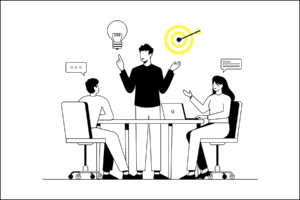A Step-By-Step Guide for Conducting Better Product Discovery

Whether you’re at a start-up or an established company, your product team is probably more focused on how they’re building what they’re building. Which makes sense. You want your new feature and overall product to work well for the user. But when so much focus is put on the “how”, the “why” of what you’re building is often taken for granted.
Until recently, many product teams have been focused on how to build products the right way, i.e. the “how” of product development, rather than figuring out which are the correct products to build in the first place, i.e. the “what” of product development.
In the past few years, “what” frameworks have advanced, but the tools to support them still tend to lag behind quite a bit. That means that product teams have managed the intricate process of making a decision on what to build next using hacked-together spreadsheets, task management tools, shared documents, and systems for managing sales, engineering, support data, as well as marketing.
Which means teams have collectively wasted an infinite amount of hours and potentially millions of dollars developing underutilized products and features that fail to live up to their ultimate potential.
So, how might one go about deciding what to build at the same time as they’re optimizing how they build their products?
Answer:product discovery.
Interested in learning more? Read on for Kissmetrics’ step-by-step guide for conducting better product discovery.
Step 1: First Things First, Understand What Product Discovery Really Means and What You’re Trying To Do
Product discovery simply refers to the process of determining the market need for your product idea. That is, it answers the question: what should we build? Product discovery plays a key role in idea generation, yet it is often overlooked.
When making the decision of what to build, teams tend to emphasize the usability of the product instead of its utility (i.e.how useful it is). The result is an unfortunate multitude of tools, products, and applications that — while simple to use — have no real reason for existing.
So, what exactly is product discovery, you ask?
Product discovery is a way to make sure the product you want to build is useful. It ensures that your program solves a true need or smooths an existing pain point. It uses evidence to prove you aren’t falling foul of wrong assumptions about consumer needs and wants.
Step 2: Realize That Product Discovery Isn’t a Linear Process
If things were simple, businesses would all have the dream product that every user loves, but the truth is that it’s much more complicated than that. Although product discovery may appear to be linear and pretty straightforward, in reality — it’s not.
Product discovery is unstructured and unpredictable. It’s quite difficult to know in advance when you’re going to learn something or how long it’s going to take. Depending on the level of uncertainty and risk associated with the business idea you’re looking to develop, there will be a lot of back-and-forth between exploration and validation.
Some of the tasks will require a couple of days to develop and test, while others will require weeks to develop and some more weeks after that to validate. In addition, you must recruit customers for interviewing or testing on a frequent basis.
Many businesses struggle to put a strong and effective product discovery process in place, reinventing the wheel every week or desperately throwing things against the wall to see if they stick. This creates quite a bit of frustration amongst teams and distrust from stakeholders — which could undermine your product development.
To prevent this from happening, consider an analytics system like Kissmetrics to help bring structure to the creative process of discovering what to build.
Step 3: Keep These Common Product Discovery Mistakes In Mind So You Can Avoid Them
To help you and your team build products that truly matter — products that actually solve real-world problems — here are a few of the most common product discovery mistakes so you can avoid them:
Jumping to Solutions Before Nailing Down Real User Problems
“If I had an hour to solve a problem, I’d spend 55 minutes thinking about the problem and 5 minutes thinking about solutions.” — Albert Einstein
While this time allocation may be a bit on the extreme side of things, understanding user problems is the most crucial step when it comes to building a product. Yet, a common mistake that product teams make is being so incredibly eager to jump to a solution that they don’t hammer down and define user problems first.
When teams don’t spend enough time unearthing user problems, they’re not able to deliver real value, wasting time and valuable resources solving the wrong problem, building the wrong solution.
Underestimating the Importance of Working With Stakeholders
It can be pretty tempting for your product team to plow directly ahead with the discovery process without involving stakeholders from both in and outside the organization.
This can cause major problems down the road for a few reasons:
- Product affects everyone
- Stakeholders have valuable insights to offer
- Product teams need stakeholder buy-in
Ideally, all stakeholders should have their requests considered during the discovery process, so when it comes time for delivery, they know exactly why their ask was included or not.
Not Involving Engineers Early in The Process
In many cases, engineers are only brought into the fold during the delivery phase — after all, that is when their skills are needed to turn great ideas into real-life features and products. However, this is problematic for three reasons:
First, engineers won’t fully understand the problem they’re trying to solve because they weren’t included in the process of defining it. They may question why a problem was picked in the first place, and product teams end up justifying their decisions rather than getting things done.
Second, product managers will be the engineer’s only reference for understanding users. So when it comes to identifying solutions, engineers may come to totally different conclusions than the product team because they didn’t play a hands-on role in getting to the bottom of user insights. Essentially, your product team will always be two steps ahead while your engineers are two steps behind.
And lastly, the product team risks missing out on exceptional ideas if engineers aren’t looped in. Engineers have a specific expertise and are usually among the smartest people in the room. They provide valuable technical insights, understand how to utilize existing functionality, and reduce effort, and can help to quickly build proof of a concept.
Step 4: Come Up With Multiple Solutions To User Needs and Start Testing Their Viability
Really explore user needs. Go beyond identifying them and try to really understand the demand of the space. Yes, this is definitely easier said than done — that’s why it’s so beneficial to incorporate an effective analytics product into your business.
Kissmetrics is a product and marketing analytics tool founded on the principle that data isn’t just a set of numbers that you simply plop into a graph. Each number represents a user, a customer, or a significant action that contributes to the overall growth of your business. It can help you and your product team to effectively come up with multiple solutions so you can start developing and testing a product with a true need.
Step 5: Don’t Be Afraid To Go Back To The Drawing Board To Add or Change Your Ideas and Plans
It takes time to create a product with a true need. If you find that your idea doesn’t work, don’t be afraid to go back to the drawing board. Brainstorm with your product team and engineers, talk to your stakeholders, and consider chatting with users. You can even implement an analytics tool like ours to really help you identify, understand, and improve the metrics that drive your business, to ultimately help develop a new product idea with a true need.
The Takeaway
Product discovery might feel a little intimidating, but it doesn’t have to be. Keep in mind that for many product teams, adopting a product discovery process is an ongoing process, so getting started is what matters most.
Not sure where to start? Kissmetrics can help with a demo — request one today here.
Sources:
https://www.britannica.com/biography/Albert-Einstein


